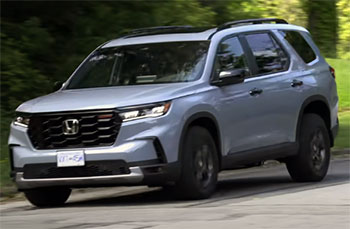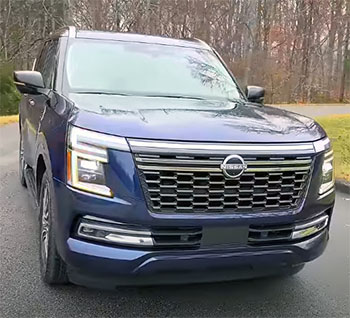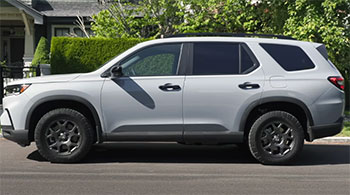As a busy parent who’s always juggling soccer practice, grocery runs, and the occasional off-road adventure, I needed an SUV that could keep up with my family’s demands. Choosing between the 2025 Honda Pilot and the 2025 Nissan Armada was no easy task—both are three-row SUVs with impressive features, but they cater to slightly different needs.
In this article, I’ll share my firsthand experience comparing these vehicles, breaking down their pros and cons, and helping you decide which one fits your lifestyle. Whether you prioritize safety, power, or affordability, I’ve got you covered with a detailed analysis.
Honda Pilot Vs. Nissan Armada Comparison
| Feature | Honda Pilot | Nissan Armada |
|---|---|---|
| Starting MSRP | $41,650 | $59,530 |
| Engine | 3.5L V6 (285 hp, 262 lb-ft) | 3.5L Turbo V6 (425 hp, 516 lb-ft) |
| Fuel Economy (Combined MPG) | 22-23 | 15-16 |
| Towing Capacity | 5,000 lbs | 8,500 lbs |
| Cargo Space (Behind 3rd Row) | 18.6 cu. ft. | 20.4 cu. ft. |
| Max Cargo Space | 87.0 cu. ft. | 87.0 cu. ft. |
| Seating Capacity | Up to 8 | Up to 8 |
| Safety Rating (IIHS) | Top Safety Pick+ | Not yet evaluated (2025) |
| Reliability (Consumer Reports) | Higher (4th overall) | Lower (12th overall) |
| Warranty Maintenance | 2 years/24,000 miles | 3 visits (longer than Pilot) |
My Experience With the Honda Pilot

Driving the 2025 Honda Pilot felt like slipping into a comfortable pair of shoes—familiar, reliable, and ready for anything.
I tested the Elite trim, which comes loaded with features like a panoramic sunroof and heated second-row seats.
The Pilot’s unibody construction gives it a car-like ride, making it a breeze to navigate tight city streets or winding highways.
Its 3.5-liter V6 engine, producing 285 horsepower, felt peppy enough for daily commutes, though it didn’t have the raw grunt I’d later experience with the Armada.
The cabin was spacious, with a clever second-row seat that can be removed for extra flexibility, a feature I found incredibly practical for family trips.
What stood out most was the Pilot’s safety suite. Honda Sensing, standard across all trims, includes adaptive cruise control, lane-keeping assist, and automatic emergency braking.
I felt confident driving with my kids in the back, especially knowing the Pilot earned a Top Safety Pick+ rating from the IIHS. The smart airbags, which adjust deployment based on passenger size, added an extra layer of reassurance.
On a weekend trip to the mountains, the Pilot’s Hill Descent Control made navigating steep trails feel effortless, a feature the Armada lacks. The cap-less fuel system was a small but delightful touch—no more fumbling with a gas cap in the rain.
However, the Pilot isn’t perfect. The base touchscreen is only 7 inches, which felt dated compared to competitors, and the throttle response was sluggish on hilly roads, forcing me to switch to Sport mode more often than I’d like. Still, the Pilot’s reliability, backed by Consumer Reports’ high ranking, and Honda’s two-year maintenance plan gave me peace of mind. It’s a versatile SUV that balances family-friendly features with a touch of adventure-ready capability.
Pros of the Honda Pilot
- Affordable Starting Price: At $41,650, the Pilot is significantly cheaper than the Armada, saving you nearly $18,000 upfront. This makes it a better financial choice for budget-conscious families who still want a three-row SUV with solid features. The lower MSRP didn’t feel like a compromise in quality, as the interior felt well-built and thoughtfully designed.
- Top-Notch Safety Ratings: The Pilot’s IIHS Top Safety Pick+ rating is a big win. Its performance in crash tests, including small overlap and side impact, was stellar. Features like knee airbags and smart side airbags that adjust for children added confidence, especially when I had my kids in the car. The multi-view camera with washers kept visibility clear, even in muddy conditions.
- Fuel Efficiency: With a combined 22-23 MPG, the Pilot sips fuel compared to the Armada. Its cylinder deactivation system helps save gas, and it runs on regular unleaded, which kept my fuel costs down during a week of errands and school drop-offs. This efficiency is a practical advantage for daily driving.
- Flexible Interior: The removable second-row middle seat is a game-changer. I could switch between seven- or eight-passenger configurations without losing cargo space. The 18.6 cubic feet behind the third row fit all my groceries, and the 87 cubic feet with seats folded handled camping gear with ease.
- Reliability and Maintenance: Consumer Reports ranks Honda fourth in reliability, with the Pilot scoring 14-29 points higher than the Armada. The included two-year/24,000-mile maintenance plan covered oil changes and tire rotations, saving me time and money. I never worried about being stranded with this SUV.
- Off-Road Capability: The Pilot’s Hill Descent Control and torque-vectoring all-wheel-drive made light off-roading a breeze. On a gravelly trail, it felt composed and capable, offering more confidence than I expected from a crossover. It’s not a hardcore off-roader, but it handled weekend adventures well.
Read More: My Thoughts On BMW X7 Vs. Cadillac Escalade
Cons of the Honda Pilot
- Underpowered Engine: The 285-horsepower V6 is adequate but lacks the punch of the Armada’s turbo V6. Merging onto highways felt sluggish, especially with a full load of passengers and cargo. I often had to floor it to keep up with traffic, which wasn’t ideal.
- Small Base Touchscreen: The 7-inch touchscreen on lower trims felt outdated and cramped. Even the 9-inch screen on higher trims wasn’t as crisp or user-friendly as I’d hoped. Navigating menus while driving was a bit clunky, and I found myself relying on my phone instead.
- Sluggish Transmission: The 10-speed automatic hesitated on hilly roads, requiring Sport mode to feel responsive. This was frustrating during a drive through rolling countryside, where I had to manually adjust to maintain smooth acceleration.
- Limited Towing Capacity: At 5,000 pounds, the Pilot’s towing capacity is decent but falls short of the Armada’s 8,500 pounds. If you need to tow a large trailer or boat, the Pilot might leave you wanting more power.
- Second-Row Seat Removal: While the removable second-row seat is innovative, it’s heavy and cumbersome to take out. I struggled to store it under the cargo floor, and it’s not something I’d want to do regularly. It’s a great idea but less practical in execution.
- Less Front Legroom: With 41 inches of front legroom, the Pilot is slightly tighter than the Armada’s 43.8 inches. As a taller driver, I noticed the difference during long drives, where I craved a bit more stretch-out space.
My Experience With the Nissan Armada

The 2025 Nissan Armada is a beast, and I mean that in the best way. I drove the Platinum trim, and its commanding presence turned heads everywhere I went.
Powered by a 3.5-liter turbo V6 pumping out 425 horsepower, the Armada felt like a muscle car disguised as an SUV. It tackled highway merges and steep inclines with ease, and the 8,500-pound towing capacity made it a clear choice for anyone hauling heavy loads.
The interior was luxurious, with high-quality materials and a spacious feel, especially for front-seat passengers.
The Armada’s tech impressed me, particularly the Intelligent Rear View Mirror, which switches to an LCD screen to eliminate blind spots—a lifesaver when the back was packed with gear.
Its 23.6-gallon fuel tank meant fewer stops on long trips, and the standard vented disc brakes provided confident stopping power.
However, the Armada’s size made it trickier to park in tight spaces, and its 15-16 MPG combined fuel economy stung at the pump.
Reliability concerns, with Consumer Reports ranking Nissan lower than Honda, also gave me pause. Still, for those craving power and luxury, the Armada delivers in spades.
Pros of the Nissan Armada
- Powerful Engine: The 3.5-liter turbo V6 churns out 425 horsepower and 516 pound-feet of torque, blowing the Pilot out of the water. It felt effortless pulling a trailer during a test tow, and highway passing was a breeze, even with a full load.
- Impressive Towing Capacity: With an 8,500-pound towing capacity, the Armada is a workhorse. I towed a friend’s boat without breaking a sweat, and the standard trailer brake controller on higher trims added extra control.
- Spacious Front Seating: The Armada offers 43.8 inches of front legroom and generous headroom, making it ideal for taller drivers. I felt like I had all the space I needed, even on a six-hour road trip.
- Luxurious Interior: The Platinum trim’s cabin felt like a premium lounge, with soft leather, wood accents, and a quiet ride. It’s a step above the Pilot in terms of refinement, perfect for those who want a touch of luxury.
- Advanced Technology: The Intelligent Rear View Mirror was a standout, switching between a traditional mirror and a camera feed. The 9-inch touchscreen (8-inch on base models) had crisp graphics, and features like adaptive cruise control were smooth and intuitive.
- Longer Fuel Range: The 23.6-gallon fuel tank gave me a longer range between fill-ups, a boon for road trips. I drove over 300 miles without needing to stop, which was a relief on a tight schedule.
Cons of the Nissan Armada
- Poor Fuel Economy: At 15-16 MPG combined, the Armada is a gas guzzler. I noticed the difference in my wallet after a week of driving, especially since it requires premium fuel, which costs about 84.9 cents more per gallon than regular.
- Higher Price Tag: Starting at $59,530, the Armada is nearly $18,000 more expensive than the Pilot. For families on a budget, this steep entry price could be a dealbreaker, especially for lower trims with fewer features.
- Lower Reliability: Consumer Reports ranks Nissan 12th in reliability, with the Armada scoring 14-29 points lower than the Pilot. This made me worry about long-term maintenance costs and potential breakdowns.
- No Hill Descent Control: Unlike the Pilot, the Armada lacks Hill Descent Control, which was noticeable on a steep off-road trail. I had to rely solely on braking, which felt less secure in tricky conditions.
- Cumbersome Size: The Armada’s larger dimensions (208.9 inches long, 79.9 inches wide) made parking in tight spaces a challenge. I struggled to fit it into a standard garage, and city driving required extra caution.
- Limited Safety Ratings: The 2025 Armada hasn’t been evaluated by the IIHS, and its NHTSA ratings are lower than the Pilot’s. Without smart airbags or knee airbags, it felt less advanced in crash protection.
Comparing the Two: Which Fits Your Needs?

After spending time with both SUVs, I realized they cater to different priorities.
The Honda Pilot is the practical choice for families who value affordability, fuel efficiency, and top-tier safety.
Its unibody design and car-like handling make it ideal for urban environments, and the flexible second-row seating is a lifesaver for growing families.
The Pilot’s reliability and maintenance plan also make it a low-stress option for long-term ownership.
I loved how it balanced daily practicality with enough capability for weekend getaways.
The Nissan Armada, on the other hand, is for those who crave power and luxury.
Its turbo V6 and high towing capacity make it a beast for heavy-duty tasks, and the spacious, upscale interior feels like a step above the Pilot. However, its poor fuel economy and higher price tag are significant drawbacks, especially if you don’t need the extra towing power.
The lack of IIHS ratings and lower reliability scores also raised red flags for me, as I prioritize peace of mind with a family vehicle.
For city dwellers or those with moderate towing needs, the Pilot is hard to beat. Its nimble handling and lower cost make it a versatile daily driver. If you’re towing heavy trailers or want a more luxurious ride, the Armada’s raw power and premium features might sway you, provided you’re okay with the fuel costs and potential reliability concerns. I found myself leaning toward the Pilot for its all-around practicality, but the Armada’s commanding presence was hard to ignore.
Family-Friendly Features
Both SUVs shine as family haulers, but they approach it differently. The Pilot’s removable second-row seat was a standout for me, letting me switch between captain’s chairs and a bench without sacrificing cargo space. Its underfloor storage compartment was perfect for stashing kids’ toys or wet gear after a beach day. The Pilot’s safety features, like the multi-view camera with washers, gave me confidence in tight parking lots or rainy conditions.
The Armada’s strength lies in its spaciousness and tech. The third row is slightly more accessible, thanks to a tilting-and-sliding second row, though it’s less comfortable than the Pilot’s. The Intelligent Rear View Mirror was a game-changer when my kids’ car seats blocked my view. Both SUVs offer ample cargo space (87 cubic feet max), but the Armada’s 20.4 cubic feet behind the third row edges out the Pilot’s 18.6. For families needing to haul strollers or sports equipment, either works well, but the Pilot’s flexibility gives it a slight edge.
Off-Road and Towing Capabilities
The Pilot surprised me with its off-road prowess. Its torque-vectoring all-wheel-drive and Hill Descent Control handled light trails with ease, making it a solid choice for occasional adventures. However, its 5,000-pound towing capacity limits its ability to haul larger trailers or boats.
The Armada is the clear winner for towing. Its 8,500-pound capacity and robust V6 made towing a breeze, and the trailer brake controller added confidence. Its higher ground clearance (9.1-9.2 inches) and sturdy build make it more capable on rugged terrain, though the lack of Hill Descent Control was a drawback. If off-roading or heavy towing is your priority, the Armada is the better pick.
Technology and Comfort
The Armada’s tech suite felt more modern, with a crisp 9-inch touchscreen and the unique rearview mirror. Its adaptive cruise control was smoother than the Pilot’s, which sometimes felt jerky. The luxurious interior, especially in the Platinum trim, made long drives feel indulgent, though the Pilot’s minimalist cabin was still comfortable and functional.
The Pilot’s base 7-inch screen was a letdown, but higher trims’ 9-inch display was adequate. The Honda Sensing suite worked well, though the lane-keeping assist could be intrusive on curvy roads. Both SUVs offer Apple CarPlay and Android Auto, but the Armada’s interface felt more polished. For tech-savvy drivers, the Armada has a slight edge, but the Pilot’s simplicity is appealing for those who prefer straightforward systems.
Cost of Ownership
Owning the Pilot is easier on the wallet. Its lower MSRP, better fuel economy, and included maintenance plan kept costs down. The Armada’s premium fuel requirement and 15-16 MPG hit hard, especially with frequent driving. Reliability concerns with the Armada also suggest higher long-term maintenance costs. For budget-conscious buyers, the Pilot is the smarter choice, while the Armada’s higher upfront cost is justified only if you need its power and luxury.
Driving Dynamics
The Pilot’s car-like handling made it a joy in the city. Its steering was precise, and the ride was smooth, even on bumpy roads. The Armada, with its body-on-frame design, felt truck-like—great for towing but less agile in tight spaces. Its firm ride on the Platinum’s 22-inch wheels was noticeable on rough pavement. If you prefer a nimble ride, the Pilot wins; for a commanding, truck-like feel, the Armada delivers.
Read More: My Thoughts On Acura MDX Vs. Volvo XC90
Frequently Asked Questions (FAQ)
It depends on your needs. The Pilot excels in affordability, fuel efficiency, and safety, making it ideal for families on a budget. The Armada is better for those needing power, towing capacity, and luxury, but it comes at a higher cost.
The Nissan Pathfinder is closer in size and price to the Pilot, but the Armada is Nissan’s full-size SUV, offering more power and towing capacity.
The Armada is larger, at 208.9 inches long and 79.9 inches wide, compared to the Pilot’s 199.9 inches long and 78.5 inches wide. The Armada also weighs 992-1,805 pounds more.
Reliability is a concern, with Consumer Reports ranking it lower than the Pilot. Owners report issues with electronics and transmission, potentially leading to costly repairs.
Conclusion: For Your Family’s SUV
You’re probably wondering which SUV I’d pick for my family, and honestly, it’s a tough call. The Honda Pilot won me over with its affordability, stellar safety ratings, and practical features like the removable second-row seat. It’s the sensible choice for most families, offering a great balance of comfort, efficiency, and reliability. But if you need to tow heavy loads or crave a luxurious, powerful ride, the Nissan Armada is hard to beat—its commanding presence and tech make it feel special. Whichever you choose, both will get you and your crew where you need to go.

